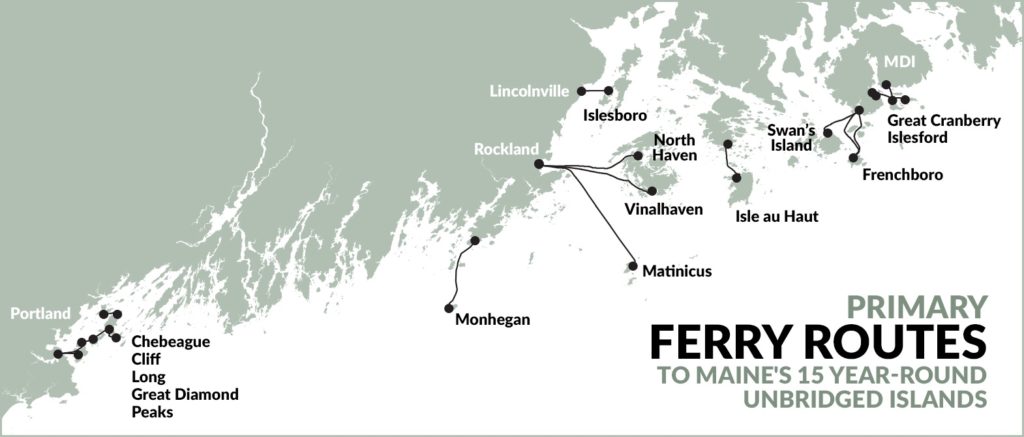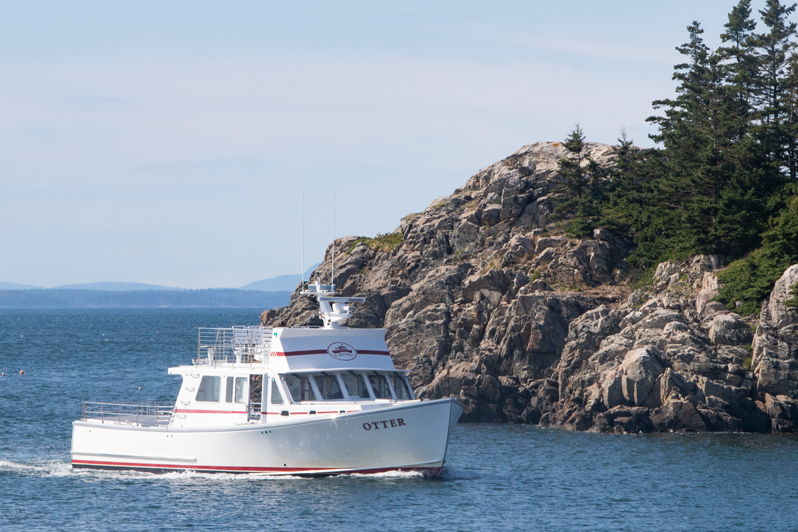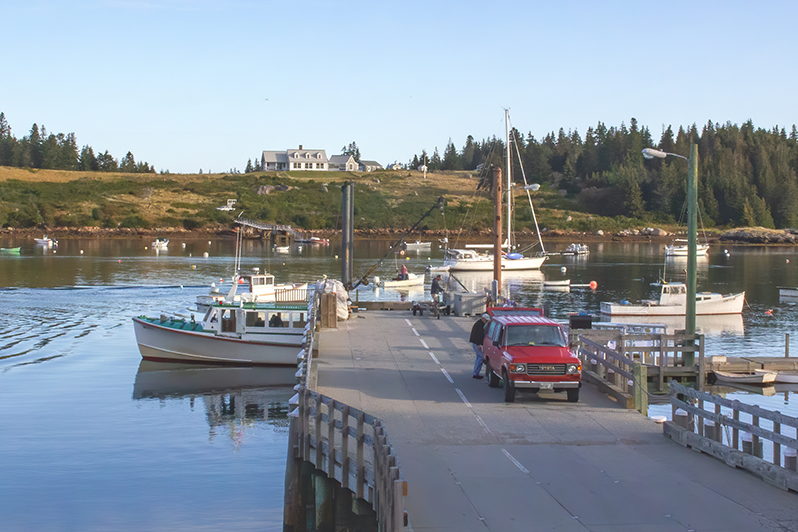BACKGROUND
Like most ferry operations, Isle au Haut Boat Services was created out of necessity. Prior to the 1970s, it was operated by a local captain with the time and resources to ferry islanders back and forth from Isle au Haut to Stonington. It was then purchased by a seasonal family on Isle au Haut as a private company and the business’s losses were covered by that family and others. In 2002, Isle au Haut Boat Services was converted to nonprofit status and is governed by a board of directors made up of seasonal and full-time island residents.
Isle au Haut Boat Services has two boats: the Mink, built in 1982, a slow but strong and resilient Maine-built craft that handles much of the island’s freight; and the Otter, built in 2016, a faster, sleeker craft that is very desirable for charters and cruises. The ferries primarily travel from Stonington to two destinations on Isle au Haut: the Isle au Haut town landing and Duck Harbor, part of Acadia National park and the access point for trails and camp sites. It typically takes about 45 minutes to get from Stonington to the island.
Isle au Haut Boat Services earns its income from a variety of sources: fares from ridership, a mail contract, and charters and cruises. An added benefit of its nonprofit status allows the ferry operation is to expand its income sources to include private donations, municipal contributions, and funds from the State. According to its website, in 2018, Isle au Haut Boat Services covered about 84% of its operating expenses from passenger, mail and freight income. The remainder was funded by the Town of Isle au Haut, by the Maine Department of Transportation (through funding from the U.S. Department of Transportation), by the National Park Service and by tax deductible contributions from private donors.
George Cole, President of Isle au Haut Boat Services and seasonal resident of the island, describes the ferry operation’s structural transitions, its innovative solutions, and other features that allow it to provide reliable transportation to and from Isle au Haut.
Q & A WITH GEORGE COLE, PRESIDENT OF ISLE AU HAUT BOAT SERVICES
The following interview has been edited for length and clarity.
Isle au Haut Boat Services has overcome hurdles while going through its transitions. Can you discuss how the operation has changed over the years and the challenges associated with those changes?
Before the 70s, it was a local service, a local man with a boat and a mail contract. It was formalized by a long-time seasonal family who bought the resources from the original owner. This was a for-profit company, though the service never made a profit, it never even broke even. The seasonal family who owned it and operated it simply supported it with some other small contributions. Over time, the family that owned the company wanted to move it on to a more stable future and guarantee continuity of the island service. The owners proposed to sell the operation to a new island group, but the main concern was to find a sustainable source of funding the operation for year round service. The conclusion was that there was no way to have it achieve financial stability unless it was turned into a nonprofit. There was considerable discussion, but in November 2002, we formed the nonprofit.
The moment you’re incorporated in a state as not-for-profit, you can then act like a 501(c)(3) pending IRS approval. After five years, if you don’t get approval from the IRS, then you have to reverse all of your donations. Isle au Haut Boat Services, as a nonprofit, acquired enough commitments from seasonal residents to operate for five years. After that, we promised to get it organized and we’d no longer need such large donations. The first thing to do was to get 501(c)(3) approval from the IRS. Unfortunately, we were turned down. If you want to become a nonprofit, you must have an approved charitable purpose. “Sustaining a year-round community” is not on the IRS’s approved list. The charitable purpose that we stated was “relieving the burdens of government” in other words, if you do something the government is supposed to do, you can get a not-for-profit status. Eventually, the IRS responded that Isle au Haut Boat Services was denied because there was no burden of government to provide transportation to Isle au Haut. I read the legislation that established the Maine State Ferry Service. It calls out six islands to be provided service, but it leaves off the rest. There is no legislation that says the government has to provide service to a year-round occupied island in Maine.
That was when Isle au Haut Boat Service went into emergency mode. There were two weeks to reply to the IRS. We made several connections to Maine’s Congressional delegation and acquired meaningful letters written to the IRS. These connections helped us achieve the goal of becoming a nonprofit. Finally in 2008 the 501(c)(3) acquired all of the assets of the private boat company and became the operation it is today.
What are the primary revenue sources for Isle au Haut Boat Services, and how has becoming a nonprofit opened up new opportunities?
First is fare. Year-round residents travel for half fare. You are considered a year-round resident if you have Isle au Haut on your driver’s license, you’re registered to vote on Isle au Haut, you’re employed for more than six months by an Isle au Haut business (for example, a sternman who needs to work with a fisherman on the island), or if management claims you are valuable to the island. There are only two examples of the last option: the summer minister who comes out to Isle au Haut and a doctor from Augusta who comes out to see patients.
During a typical year, there are also cruises that generate income. Having two boats allows for flexibilities with cruises and charters. Charters are a growth area for the ferry operation because the newer boat, the Otter, is faster and cleaner, and it’s an attractive boat. Charters and excursions are much easier with the Otter. Our charters trips are weddings, memorial services, and scheduled outings as far away as North Haven, Rockland, or Allen Island.
The mail contract is another way revenue is generated by Isle au Haut Boat Services. We carry the mail six days a week. It’s a competitive bid contract, and it has to be renewed every four years.
The other funding sources are available due to our status as a nonprofit. After a lot of work and support from state politicians, we were able to get included in a Maine Department of Transportation program which funds rural transportation. This is the “Section 53 11” program (named after the section in the federal law that effectuated the funding). The source for those funds is federal—a federal program that supports both rural and urban transportation. Funds go to state in proportion to each state’s population among other criteria, and then the state manages the funds. The people who manage these funds at the state level are exceptional. Isle au Haut Boat Services qualified for that program after becoming a nonprofit. The program mostly supports things like buses. Private ferry companies can’t get on the program, only town governments, nonprofits, and transit districts. For us, the 5311 funding will cover 50% of operating losses for scheduled routes, up to a cap assigned by Maine DOT. Operating costs not associated with scheduled public transportation are not covered by the 5311 program. The other 50% has to be matched with local funding.
We needed to figure out how to match that 50%, so I stood up at a town meeting and stated that we needed money. The town had given money to other nonprofits before—small grants, but this was a larger ask. I stated that we were coming up with the 5311 funding, but we had to come up with the match for it. There was initially a long discussion at that town meeting, but over the years, the town came to understand the importance of allocating that money. Now there isn’t so much discussion surrounding it, and the town supports the match. Because of this, we try to have a representative from Isle au Haut Boat Services at the town meetings. If you’re asking the town for money, you need to show up!
I also still do an annual fundraising appeal. This, of course, does not support all expenses but it does help with the local match. I mail appeals to people connected to the island, and I can expect a decent percentage of donations varying greatly in amount.
What’s it like operating within a National Park?
It’s a benefit that we get to operate within a national park because that increases our ridership. We have a very good relationship with the park, and the park management is very sensitive to the town of Isle au Haut’s concerns. Campers and hikers make up a considerable portion of our passenger count. We have an agreement with the park regarding a few things we do provide for them. For example, park rangers in uniform get to travel without a fare. There’s a parking place for park rangers at our dock. There’s poster space at our dock that explains the park experience. Isle au Haut Boat Services provides transportation to Stonington for injured campers. The cooperative agreement includes an annual grant from the National Park Service for the benefits that Isle au Haut Boat Services provides them.
What unique attributes does Isle au Haut Boat Services have that give it an advantage?
The smartest thing that the original family who purchased Isle au Haut Boat Services did was buying the current operating facility in Stonington. It was originally a fish processing plant that was built in the early 1900s, but when it entered bankruptcy in the 1990s, the boat company bought it. It was an incredibly smart and valuable thing that they did because within ten miles either way of Stonington, there just isn’t any other proper place to operate a ferry. Before that, the boat operated from a public facility nearby. It was not a very good operating location because you couldn’t get into the wharf at all tides and handling freight was a challenge. Now we have a wharf that is usable at all tides, has outdoor and indoor parking, and has a place for an office and a workshop. Without it, we’d be out of business because the former landing isn’t public anymore. The Mailboat Company and the island owe a tremendous debt of gratitude to the family who operated the company for over thirty years, and who passed on to us a reliable working service with proper infrastructure.
Our full-time employees are another unique asset. Our three year-round captains have local connections and valuable certifications. They’re stable long-term employees. In the past, we’ve paid for the expenses it takes for an employee to become a licensed boat captain. If they choose to work for us for a year, then the cost to the employee is free. Our employees are the most important part of operating the service. You’ve got to have a boat of course. It has to be a good boat, and it has to be well maintained, but the people who run it are the ones who make it happen.
What does good leadership look like when operating a ferry service?
A good ferry service is responsive. I view our board as the ears and eyes in various parts of the community. The board consists of 50% year-round residents and 50% long term seasonal residents. The board meetings are based on hearing how different parts of the community are responding to different issues. We do our best to take all residents’ opinions into consideration. For example, in the winter time there used to be two trips a day, six days a week. One leaving the island in the morning, one leaving the island in the late afternoon. At a town meeting, a resident suggested that there be an occasional midday boat so a contractor could come off the island midday or if someone had an appointment in the morning, they could come back at lunch time that day. Since it was a logical idea, the next week, we changed the schedule to include a midday boat three days a week. It pays off when you listen to the local needs.
RESOURCES
- Isle au Haut Boat Services Website
- Federal Transit Administration – Section 53 11 Funding Information
- Federal Transit Administration – Section 5311 Fact Sheet
Originally Published June 2020.




